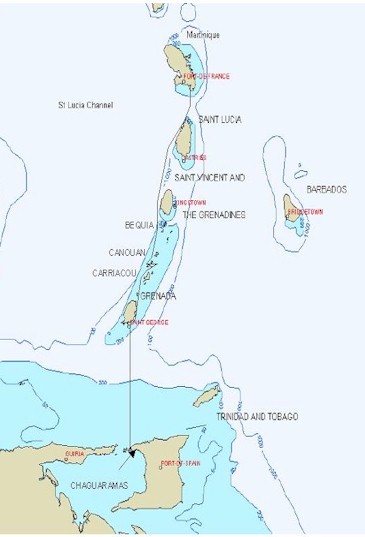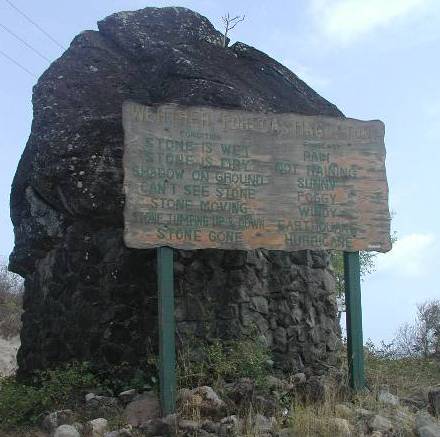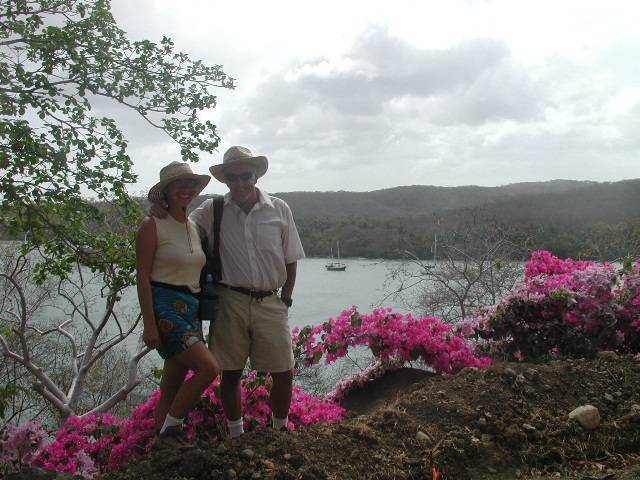Martinique to Trinidad
26th March - 3rd April 2003
Well, we've learned that there are plans and there is sailing and that the two are pretty incompatible. We left Sainte Anne in Martinique for Trinidad, in search of a more reasonable boatyard. Our intention was to sail directly from Martinique to Trinidad, which would take about 48 hours, this would avoid using the engine and worsening the situation with our cutlass bearing. We decided against taking the easier option of shorter hops with overnight anchorages for that reason, as we'd have to motor in and out of each of the anchorages on the way. If we had the forecast wind, slightly north of east, we should be able to make the course fine.
So, stocked up with supplies for maybe three days, we left Sainte Anne. We had only been underway when Christine lost her sunglasses overboard, great. We set off in an easterly wind which, needless to say, began to turn not north but south of east. This would make it impossible to clear Saint Lucia without putting in a long tack, a change of course away from our destination, to make enough easting to clear the island. So, two hours into our two day trip, we were forced to change course and head for Rodney Bay in Saint Lucia, where we would anchor overnight. At least we thought we'd be able to get some sleep that night. The late night party animals of Gros Islet had other ideas, their loud music finished finally at 3.30 am putting us in a fine humour for our 5.30 am departure for Bequia.

Route we took from Martinique to Chaguaramas, Trinidad.
We finally reached Admiralty Bay, Bequia after a boisterous crossing from St. Vincent, just before dark. We were so tired that we'd anchored behind friends we'd made in Martinique on Cheshire Cat and not noticed. Luckily Mike, originally from Port Talbot in Wales, came by to say hello.
Next morning we called to see friends on Sundowner as well. We hadn't seen Ann and John since Venezuela last year, when Ann was laid up with a broken ankle. It was good to see her up and about, although on talking to them, it seems their run of bad luck has continued first with an engine room fire and most recently when their boat almost sunk in Bequia at anchor when their stern gland failed. Despite all of it it was good to see them again in good spirits and everything almost dried out.
We've noticed a big difference between last year and this year when we enter anchorages. Now when we enter an anchorage its rare to find that there is nobody there we know and its great when old friends come up to say hello and welcome.
After our tiring two long days of sailing we decided to put in a couple of shorter legs, the first to Canouan, about 15 miles south of Bequia. We hauled up our anchor around midday and then promptly lost our halyard up the mast (again) when the clip attaching it to the top of the mainsail came undone. The Captain really seems to like climbing up the mast to retrieve the halyard, although from his language on this occasion you wouldn't think so!
So, we hauled up our anchor again and set off again around 1 pm. We were pleased to be able to sail nearly all the way to Canouan and enjoy the local delicacy of rotis (curry in a flat bread wrap) on our way. We also saw a small pilot whale broach during our trip which was a wonderful experience. He'd be better advised to perform somewhere else though, as they are still licensed to catch 4 or 5 whales a year in Bequia.
On arrival in Canouan we were greeted by friends Sue and Leon of Masade and Judy and Jim of Valiant Lady, who dragged us ashore for happy hour.
Next morning we were off again, this time to Carriacou and had a wonderful sail through the idyllic Grenadines past Mayreau and Union island. Hopefully we WILL get to stop there again soon, it seems our routes are always directed by repairs we need to make at the moment.
On our way to the anchorage in Carriacou we passed friends on Moonrise but couldn't raise them on VHF, instead we got a call from Carolyn on Windbourne III, asking when we'd be in Tyrrel Bay. As a result our plans changed and we decided to head there instead of the anchorage we'd decided on earlier. Needless to say we ended up at happy hour in the yacht club with Carolyn and Rick, Graham and Anne from Rasi and Michael and Joanne from Orion, all of whom we'd met in Hartman Bay last year.
We were in need of a drink after a scary experience earlier in the day when a Moorings charter catamaran came into the anchorage and decided to drop their anchor directly on top of our anchor. No, not so that their chain crossed our anchor chain, but so their anchor was actually on top of our anchor, which would obviously mean that they would end up in exactly the same spot where we were. Perhaps a crash (no pun intended) course in anchoring would be a good idea for novice yacht charterers before they are let loose to terrorise perfectly peaceful anchorages. Anyway eventually a combination of Christine standing on the deck with a look of complete disbelief, a large fender ready in one hand and the camera in the other to take photos in case of collision and a local man's offer to guide them to one of his mooring buoys instead and they moved off, luckily without tangling themselves with Anju or pulling up our anchor in the process.
Next day we decided to head straight for Trinidad, which would probably take around 24 hours. Orion were heading the same way so we said we'd see them in Trinidad. They would be stopping at Grenada on the way.
We left around 11 am and whilst sailing away from Carriacou in quite a lumpy sea, we noticed that our VHF aerial looked loose. As we sailed on it seemed to get worse, so we decided we should stop off at St. David's on the south coast of Grenada to anchor and resecure it before heading on to Trinidad. Too late! As we sailed along the windward side of Grenada, on glancing up to check it, we noticed it was gone, leaving us with no VHF. We do have a handheld unit but it just doesn't seem to hold its charge at all and could only be used in the case of an emergency, so we decided now we would have to stop overnight in St. Davids, where luckily there is a chandlery, and buy and fit a new antenna. (See what we're saying about planning our route around what we have to fix?). We were quite surprised on our way down the coast of Grenada to pass a couple of local men out in a small boat fishing. Life was uncomfortable enough on board Anju, never mind in a small wooden boat. We also passed a school of bright pink plastic inflatable fish!
So, we surprised Orion when we arrived in St. David's just before dusk after passing along the entry channel, which is well marked but nerve-wracking with waves breaking on reefs on either side. It was our first visit to St. Davids. Of course we were dragged ashore again for happy hour. Perhaps we should rename this trip the "Happy Hour Tour" of the Windward Islands.
Next spanner in the works was that the following day turned out to be a bank holiday in Grenada, so the shop was closed and we couldn't buy our antenna, instead we had to spend a pleasant day beach-combing with Joanne and Michael, looking for shells to decorate our fish tank. The guppies and swordtails don't seem to mind swimming uphill in their tank when we're beating to windward! In the afternoon we had decided to take a walk with our friends over to the La Sagesse Nature Reserve over in the next bay but when we were tying up our dinghy, Eric, the friendly security man at the Bel Air Resort, warned us that people had just been robbed whilst doing that very walk and the police were still seeking the robbers. We decided instead to take up his offer of a tour of the newly built and beautifully laid out resort complex, including the amazing weather-forecasting stone (see below), followed by a cold beer at the bar afterwards.

Touring the Bel Air Plantation Resort

We left St. Davids at around 6 pm, just before dark, thinking of those reefs around the entrance to the bay. The forecast was for easterly winds 15 - 20 knots but for the first half of our passage we had a constant 25 knots and the sea was quite lumpy. Orion would be leaving to make the same trip at around 3 am, so we had arranged to call them initially on VHF and later, as we became further apart, on SSB radio.
Later in the passage, at around 10.30 pm when Christine was on watch, we approached a confusing set of strobe lights. After much debate about what it was and which direction it was heading, we decided to give it a wide berth for safety's sake. Some sailing yachts and small boats at sea display strobe lights instead of the regulation navigation lights, presumably in order to save power. The disadvantage of this practice is that mariners can ascertain a lot of information from navigation lights on a dark night, such as which direction a vessel is heading and the size of the vessel, whether it is a special kind of vessel such as a fishing boat or vessel which cannot manoeuvre easily and all of this is lost if all you can see is a strobe. We have also heard of yachts which only display navigation lights when they spot another vessel at sea and of such unlit yachts narrowly avoiding colliding with one another at sea. For this reason we have always displayed the correct regulation navigation lights.
A couple of hours later we picked up a tanker on the VHF apparently talking to a yacht in distress, however we weren't able to pick up the transmissions of the yacht for some reason. On noting the position of the yacht, that could have explained the strobe lights we'd seen earlier but we were puzzled as to why we'd heard no distress calls from them on the VHF. We felt bad that we may have sailed straight past another yacht in trouble but on monitoring the very professional rescue carried out in the difficult sea conditions by the British crewed tanker Lesley PG, they were much better equipped to carry out a rescue than us. The crew of the yacht were taken aboard the tanker and their yacht, which was taking on water and their liferaft had to be abandoned adrift due to the sea state. We called up our friends following behind us and the Caribbean Safety and Security Net, to warn of the potential hazard still afloat.
Apart from on-going rescues, there is only one major hazard between Grenada and Trinidad, a large oil rig. We planned to pass about two miles east of the rig. As we approached it the wind suddenly dropped off and with the strong west flowing current and our sudden drop in speed, we found ourselves being pushed towards the rig. The motor had to go on again until we were safely past the rig. The wind didn't really pick up again, so we had to carry on under motor. So much for our plan to try not to use the engine.
As we approached Trinidad's north coast Phil caught and lost a dorado or Mahi Mahi, which we disappointed about, as they are delicious. Later he managed to land a tuna but it was too small, so he released it again. Luckily our friends on Orion had more luck and caught a sailfish, which they later shared with us.
On arrival in Chaguaramas Bay, the yachting centre of Trinidad, we tied up at the customs dock to check in. The dock was so high, it being low tide, that as we approached intending to tie up starboard side to the dock, we were afraid that our outboard engine, mounted on the starboard rails, might get caught on the dock. A swift U-turn accompanied by frantic scrabbling on deck to reposition fenders and mooring lines followed and then we were safely tied up in Trinidad after our eventful trip.